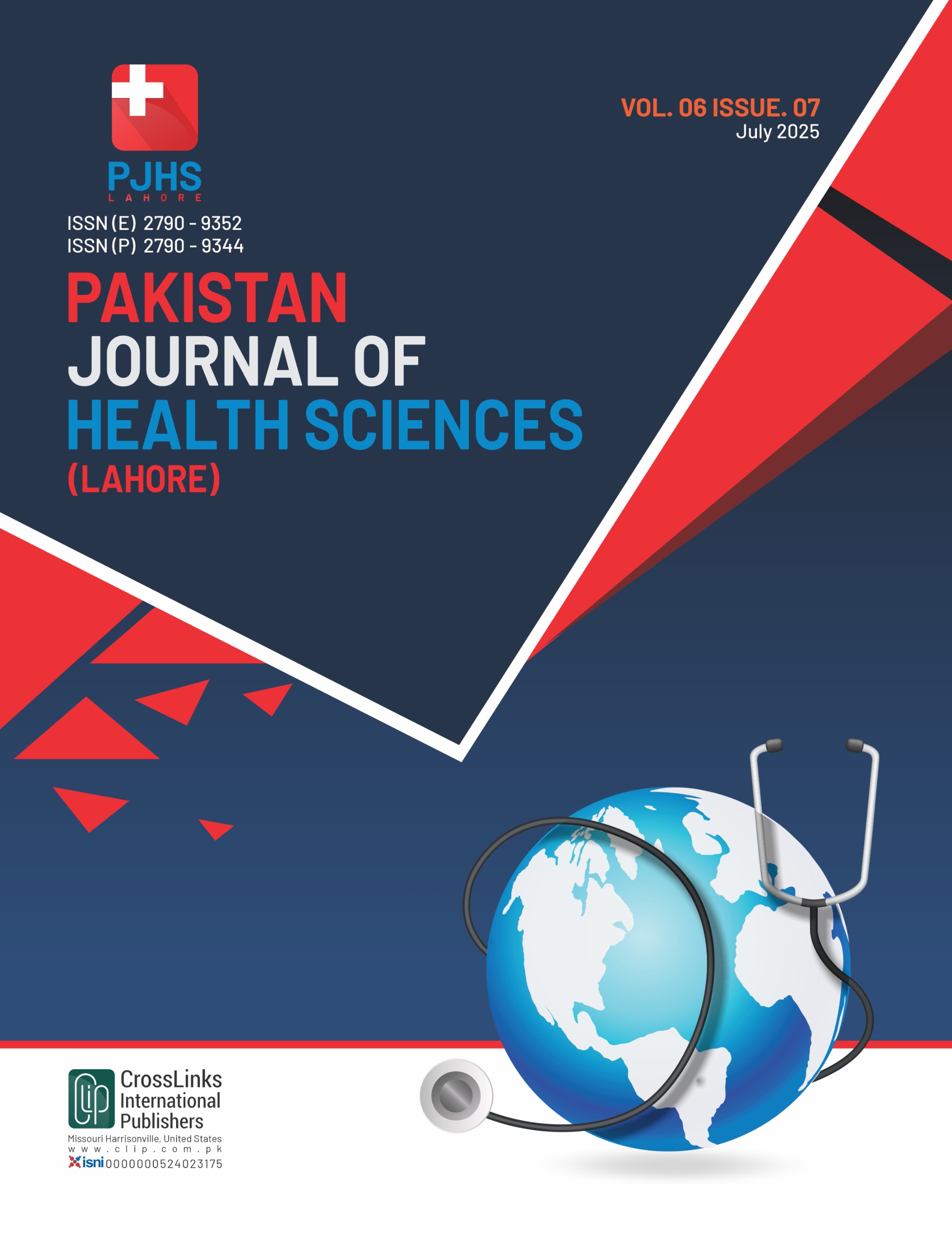Frequency of Hypertension in Patients with Intracranial Hemorrhage Presenting to Emergency Department
Hypertension in Patients with Intracranial Hemorrhage
DOI:
https://doi.org/10.54393/pjhs.v6i7.3271Keywords:
Intracranial Haemorrhage, Hypertension, Stroke, Emergency Department, Blood Pressure, Risk FactorsAbstract
Intracranial haemorrhage is a serious neurological emergency with high morbidity and mortality. Hypertension is a known major risk factor; however, local data regarding its frequency in intracranial haemorrhage patients remain limited. Objectives: To determine the frequency of hypertension among patients with intracranial haemorrhage presenting to the Emergency Department (ED) of Lady Reading Hospital, Peshawar. Methods: This cross-sectional study was conducted at the ED of Lady Reading Hospital from April to September 2023. A total of 182 patients aged 30–70 years, diagnosed with intracranial haemorrhage via CT scan, were enrolled using consecutive sampling. Blood pressure, BMI, demographic data, and socioeconomic status were recorded. Hypertension was defined as SBP ≥140 mmHg, DBP ≥90 mmHg, or self-reported antihypertensive medication use. Data were analyzed using SPSS version 26.0, with the chi-square test (p<0.05 considered significant). Results: Patients had a mean age of 50.24 ± 12.24 years and a mean BMI of 25.74 ± 4.41 kg/m². Hypertension was found in 155 patients (85.2%). There were no significant associations between hypertension and gender (p=0.364), age groups (p=0.817), or socioeconomic status (p=0.613). Conclusions: Hypertension prevalence was high among intracranial haemorrhage patients. This emphasizes the need for improved hypertension management and preventive strategies in the community.
References
Bako AT, Pan A, Potter T, Tannous J, Johnson C, Baig E et al. Contemporary Trends in the Nationwide Incidence of Primary Intracerebral Hemorrhage. Stroke. 2022 Mar; 53(3): e70-4. doi: 10.1161/STROKEAHA.121.037332. DOI: https://doi.org/10.1161/STROKEAHA.121.037332
Mengel A, Siokas V, Buesink R, Roesch S, Laichinger K, Ferizi R et al. Continuous Arterial Blood Pressure Indices and Early Hematoma Expansion in Patients with Spontaneous Intracerebral Haemorrhage. Brain Haemorrhages. 2024 Oct; 5(5): 213-22. doi: 10.1016/j.hest.2024.06.001. DOI: https://doi.org/10.1016/j.hest.2024.06.001
Kölbl K, Hock SW, Xu M, Sembill JA, Mrochen A, Balk S et al. Association of Non-Contrast CT Markers with Long-Term Functional Outcome in Deep Intracerebral Haemorrhage. Frontiers in Neurology. 2024 Jan; 14: 1268839. doi: 10.3389/fneur.2023.1268839. DOI: https://doi.org/10.3389/fneur.2023.1268839
Ezeonu S, Capasso A, Vollano N, Rodriguez-Rivera J, Maglaras C, Raman T. P15. Determining Factors of Postoperative Lumbar Epidural Hematoma: Hypertension and Elevated Postoperative Diastolic Pressure Significantly Increase Risk. The Spine Journal. 2024 Sep; 24(9): S70. doi: 10.1016/j.spinee.2024.06.036. DOI: https://doi.org/10.1016/j.spinee.2024.06.036
Gil-Garcia CA, Flores-Alvarez E, Cebrian-Garcia R, Mendoza-Lopez AC, Gonzalez-Hermosillo LM, Garcia-Blanco MD et al. Essential Topics About the Imaging Diagnosis and Treatment of Hemorrhagic Stroke: A Comprehensive Review of the 2022 AHA Guidelines. Current Problems in Cardiology. 2022 Nov; 47(11): 101328. doi: 10.1016/j.cpcardiol.2022.101328. DOI: https://doi.org/10.1016/j.cpcardiol.2022.101328
Di Chiara T, Del Cuore A, Daidone M, Scaglione S, Norrito RL, Puleo MG et al. Pathogenetic Mechanisms of Hypertension–Brain-Induced Complications: Focus on Molecular Mediators. International Journal of Molecular Sciences. 2022 Feb; 23(5): 2445. doi: 10.3390/ijms23052445. DOI: https://doi.org/10.3390/ijms23052445
Thomas SE, Plumber N, Venkatapathappa P, Gorantla V. A Review of Risk Factors and Predictors for Haemorrhagic Transformation in Patients with Acute Ischemic Stroke. International Journal of Vascular Medicine. 2021; 2021(1): 4244267. doi: 10.1155/2021/4244267. DOI: https://doi.org/10.1155/2021/4244267
Alkahtani R. Molecular Mechanisms Underlying Some Major Common Risk Factors of Stroke. Heliyon. 2022 Aug; 8(8). doi: 10.1016/j.heliyon.2022.e10218. DOI: https://doi.org/10.1016/j.heliyon.2022.e10218
Dong H, Liu S, Jing L, Tian M, Sun J, Pang Y et al. Hypertension among Haemorrhagic Stroke Patients in Northeast China: A Population-Based Study 2017–2019. Medical Science Monitor: International Medical Journal of Experimental and Clinical Research. 2020 Dec; 26: e926581-1. doi: 10.12659/MSM.926581. DOI: https://doi.org/10.12659/MSM.926581
Lioutas VA, Beiser AS, Aparicio HJ, Himali JJ, Selim MH, Romero JR et al. Assessment of Incidence and Risk Factors of Intracerebral Haemorrhage Among Participants in the Framingham Heart Study Between 1948 and 2016. Journal of the American Medical Association Neurology. 2020 Oct; 77(10): 1252-60. doi: 10.1001/jamaneurol.2020.1512. DOI: https://doi.org/10.1001/jamaneurol.2020.1512
Cantone M, Lanza G, Puglisi V, Vinciguerra L, Mandelli J, Fisicaro F et al. Hypertensive Crisis in Acute Cerebrovascular Diseases Presenting at the Emergency Department: A Narrative Review. Brain Sciences. 2021 Jan; 11(1): 70. doi: 10.3390/brainsci11010070. DOI: https://doi.org/10.3390/brainsci11010070
Kuhn D, Tiffany L, Beher R, Boswell S, Giraldo D, Hassan M et al. Blood Pressure Management in Emergency Department Patients with Spontaneous Intracerebral Haemorrhage. Blood Pressure Monitoring. 2020 Dec; 25(6): 318-23. doi: 10.1097/MBP.0000000000000473. DOI: https://doi.org/10.1097/MBP.0000000000000473
Shen J, Guo F, Yang P, Xu F. Influence of Hypertension Classification On Hypertensive Intracerebral Haemorrhage Location. The Journal of Clinical Hypertension. 2021 Nov; 23(11): 1992-9. doi: 10.1111/jch.14367. DOI: https://doi.org/10.1111/jch.14367
Tran QK, Najafali D, Tiffany L, Tanveer S, Andersen B, Dawson M et al. Effect of Blood Pressure Variability on Outcomes in Emergency Patients with Intracranial Haemorrhage. Western Journal of Emergency Medicine. 2021 Jan; 22(2): 177. doi: 10.5811/westjem.2020.9.48072. DOI: https://doi.org/10.5811/westjem.2020.9.48072
Bullo N, Baqir R and AFZAL M. Frequency of Factors Leading to in-Hospital Mortality in Patients Presenting with Intracerebral Hemorrhage. Biological and Clinical Sciences Research Journal. 2023. 2023(1): p. 324. doi: 10.54112/bcsrj.v2023i1.324. DOI: https://doi.org/10.54112/bcsrj.v2023i1.324
Goswami B and Nanda V. Clinical Profile of Patients with Hypertensive Crisis Presenting to an Emergency Department of a Tertiary Care Hospital in Western India. Apollo Medicine. 2024 Jun; 21(2): 148-52. doi: 10.4103/am.am_121_23. DOI: https://doi.org/10.4103/am.am_121_23
Nazeer M, Baig FA, Khan TU, Masood A, Hamid M, Sarwar S. Frequency of Elevated Systolic Blood Pressure and Early Mortality in Patients with Intracerebral Haemorrhage. The Professional Medical Journal. 2022 Jun; 29(07): 981-5. doi: 10.29309/TPMJ/2022.29.07.6636. DOI: https://doi.org/10.29309/TPMJ/2022.29.07.6636
Patel S, Parikh A, Okorie ON. Subarachnoid Haemorrhage in the Emergency Department. International Journal of Emergency Medicine. 2021 Dec; 14(1): 31. doi: 10.1186/s12245-021-00353-w. DOI: https://doi.org/10.1186/s12245-021-00353-w
Ullah Z, Iltaf S, Zaheer M, Iqbal A, Alam M, Pechuho SU. Frequency of Severely Elevated Blood Pressure on Admission in Known Hypertensive Patients Presenting with Acute Haemorrhagic Stroke. Pakistan Heart Journal. 2022 Mar; 55(1): 53-6. doi: 10.47144/phj.v55i1.2206. DOI: https://doi.org/10.47144/phj.v55i1.2206
Prabhu VV, Sharma PK, Parihar A, Gupta SK, Garg RK, Abbas H et al. Clinico-radiological Characteristics and Outcomes of Spontaneous Intracerebral Haemorrhage in Patients with and without Hypertension: A Study Comparing Spontaneous Hypertensive Versus Non-Hypertensive Intracerebral Haemorrhage. Journal of Stroke Medicine. 2024 May: 25166085251337181. doi: 10.1177/25166085251337181. DOI: https://doi.org/10.1177/25166085251337181
McGurgan IJ, Ziai WC, Werring DJ, Salman RA, Parry-Jones AR. Acute Intracerebral Haemorrhage: Diagnosis and Management. Practical Neurology. 2021 Apr; 21(2): 128-36. doi: 10.1136/practneurol-2020-002763. DOI: https://doi.org/10.1136/practneurol-2020-002763
Downloads
Published
How to Cite
Issue
Section
License
Copyright (c) 2025 Pakistan Journal of Health Sciences

This work is licensed under a Creative Commons Attribution 4.0 International License.
This is an open-access journal and all the published articles / items are distributed under the terms of the Creative Commons Attribution License, which permits unrestricted use, distribution, and reproduction in any medium, provided the original author and source are credited. For comments













